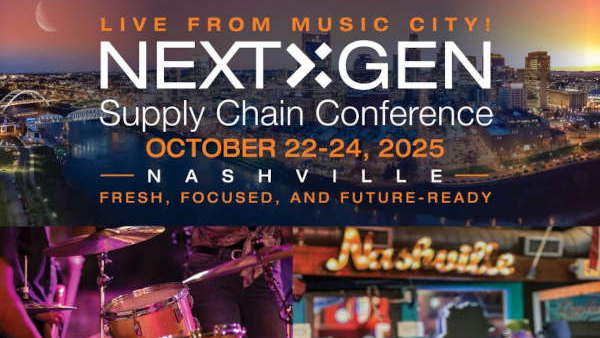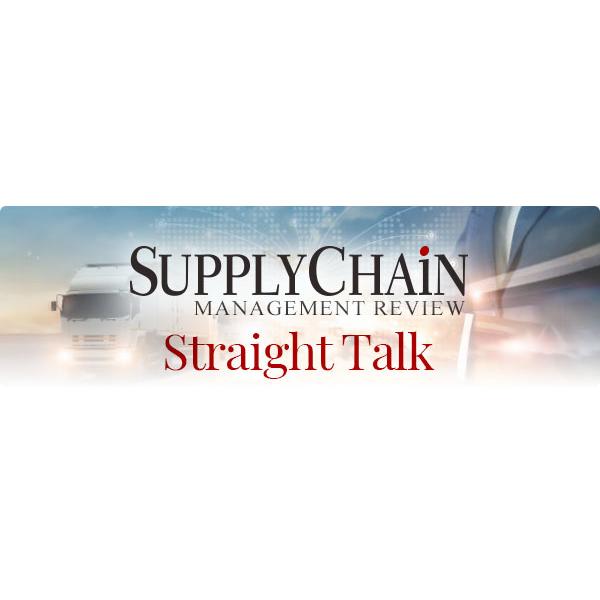|
Straight Talk with Brian Straight • October 26, 2025
|
|
|
|
Hello, and welcome to this week’s edition of Straight Talk. Inside, we discuss:
-
Viewing procurement’s future
-
A heartfelt thank you
-
Sustainability still matters
-
Freight rail policy overhaul
|
|
If this was forwarded to you and you wish to receive it each Sunday morning in your email, please go here to sign up for SCMR newsletters.
|
|
|
|
|
|
|
Sponsored
|
|
Intelligence That Moves Logistics Forward
|
|
|
|
Logistics leaders need clarity and control. Aptean’s Next Gen Routing & Scheduling delivers unified intelligence across planning and execution, helping fleets cut manual work, model scenarios and protect margins. Beyond automating operations for efficiency’s sake — make smarter decisions when every mile matters.
|
| See What’s New in Next Gen Routing |
|
|
|
 |
|
(Photo: Getty Images)
|
|
Back in May, we published an article on setting up your procurement processes for the future in Supply Chain Management Review. Because the article requires an SCMR subscription to read, I thought I’d share some of what the authors left readers with in this week’s newsletter.
Authors Dan Pellathy, faculty of practice and operations director of the Advanced Supply Chain Collaborative at the University of Tennessee-Knoxville, and Jadé Johnston, director of global supply chain for commercial & international sector, EIA, UK, & Europe at Leidos, made the argument that procurement stands at a crossroads. The function can no longer rely on legacy systems or isolated roles—it must evolve into a proactive driver of business value. The pair highlights how leading organizations are redesigning procurement structures to integrate more closely with supply chain and commercial teams, creating earlier influence in decision-making.
The future of procurement, they write, depends on developing three foundational capabilities: customer value management, cross-functional integration, and talent pipeline development. These are the building blocks for broader capabilities like operational excellence, partnership management, and continuous improvement. The authors conclude that procurement’s next evolution will come from shifting its identity—from a process enforcer to a strategic partner that fuels innovation, customer satisfaction, and long-term growth.
What follows is a key section of the article, as Pellathy and Johnston wrote it. (You can read the full article on scmr.com – subscription required)
|
|
——————–
|
|
Procurement teams are trying to apply yesterday’s toolkit to solve tomorrow’s problems. Pressing internal challenges include system complexities, supply network vulnerabilities, and evolving customer requirements. Externally, a rapidly changing technological landscape, punctuated by geopolitical and economic disruptions, demands constant adaptation. At the same time, procurement leaders must continuously improve the cost, quality, and speed of supply.
Under these pressures, traditional systems and practices do not adequately equip procurement teams for success. Procurement professionals are expected to adapt to a stream of new tasks, process changes, and product initiatives. Yet procurement remains disconnected from broader supply chain and customer-led decisions. Too often procurement is engaged only after decisions have been made, forcing teams to react as best they can. Overwhelmed by requests, yet unable to influence decisions, it is not surprising that procurement teams are experiencing record levels of burnout.
|
|
Breaking free from legacy silos
|
|
Leaders emphasized that current organizational structures often act as a barrier to procurement value contribution. Despite talk of breaking down functional silos and endless organizational reshuffles, procurement leaders still feel disconnected from the broader supply chain and customer-facing areas of the company.
A typical organizational design, for example, positions commercial teams as the primary point of contact with customers, with procurement acting as a “support function.” Breakdowns occur at multiple points. Commercial teams’ desire to accommodate customer requests related to customization and timing clash with procurement’s mandate to generate efficiencies through standardization. Rather than supporting value generation, procurement capabilities are oriented toward maintaining processes and enforcing policies. Experience of procurement as imposing constraints rather than generating value-add solutions reinforces to commercial teams that engagement should be avoided.
Leading companies are facing this problem head-on. Consider the example of a global leader in construction equipment. In response to a highly dynamic regulatory environment, the company reorganized its procurement function. Before the reorganization, communication with suppliers had been fragmented while functional boundaries separated procurement from the business. Today, each business vertical has a vice president of procurement, supported by a central strategic procurement division. An additional senior vice president has ownership over process innovation, tools, and risk. The new structure allows procurement to be much closer to customers when supporting cost, availability, and after-sales services.
|
|
Laying a foundation for the future of procurement
|
|
Although organizational design is important, equally important is the development of foundational capabilities that position procurement for future success. Leading companies that we spoke with identified three foundational capabilities for the future: customer value management, cross-functional integration, and talent pipeline management. Senior leaders were adamant that any effort to position procurement teams for future success depends on these foundational capabilities.
Customer value management emerged as the area most in need of capability development. Procurement teams must have a deep understanding of customers and lead with value innovation based on a detailed understanding of supply chain processes. One senior executive described a strategy of “insourcing customer intimacy.” His procurement team focuses on hiring associates from key customers. New hires bring years of experience, helping the procurement team design offerings that address customer needs.
Along with customer value management, procurement teams must enhance their capabilities in cross-functional integration. This requires aligning goals, effectively managing business processes, and maintaining reciprocal flows of information across areas of the company. One way to build this capability is through focused work on a specific initiative. The procurement team at a durable goods company we spoke with helped lead an effort to reduce lead times at every step in the order fulfillment process. Procurement worked with more than 100 suppliers to reengineer their ordering process, with a special emphasis on shrinking component supply lead times. Through this initiative, procurement established strong working relationships with other areas while demonstrating its ability to deliver on project goals.
Finally, the need for talent emerged as procurement leaders’ number-one long-term constraint. A capability in talent pipeline management is therefore critical to the success of any procurement effort. Here, teams need to focus on defining future-oriented procurement competencies (knowledge, skills, attitudes) and then creating broad-based experiences for growth. Benchmark supply chains are particularly focused on competencies that extend beyond traditional technical skills to include change management, compelling communication, team leadership, influence, and technological fluency.
Procurement is at a pivotal juncture. Driven by a rapidly changing business environment and evolving customer expectations, the need to enhance procurement’s value impact is greater than ever. Benchmark leaders are meeting this challenge by redesigning how their procurement organizations create value. From customer management and stakeholder engagement to talent development, these leaders are envisioning the future of procurement. And the future looks bright.
Subscribe to Supply Chain Management Review to read more of this type of long-form, in-depth analysis, research, thought leadership. Subscribe here.
|
|
Thank you
|
 |
|
|
|
We just wrapped up the 2025 NextGen Supply Chain Conference. For the first time, we took the show on the road to Nashville, and the Music City did not disappoint. From our fabulous speakers to our supportive sponsors, and of course everyone behind the scenes, I want to extend my sincere thanks to everyone who helped make this year’s event our best yet. From our visionary keynote speakers and insightful panelists to the sponsors and exhibitors who brought cutting-edge technologies to life, your energy and expertise defined what “next generation” truly means. Over three days, we explored how AI, automation, data, and human ingenuity are transforming supply chain operations and it was inspiring to see so many leaders sharing ideas, experiences, and solutions. To all who attended, participated, and supported the event—thank you. Your engagement is what continues to make NextGen such a vibrant community of innovators driving the industry forward and I can’t wait to begin sharing information on next year’s conference.
|
|
Sustainability matters
|
 |
|
(Photo: Getty Images)
|
|
|
|
|
Sustainability is still an important metric for businesses, according to a new survey from the MIT Sustainable Supply Chain Lab, conducted in collaboration with CSCMP. The survey of over 1,200 professionals in 97 countries found the challenge to not be the willingness, but rather the ability to track sustainability. “What we found is strong evidence that sustainability still matters,” said Josué Velázquez Martínez, a research scientist and director of the MIT Sustainable Supply Chain Lab. “There are many things that remain to be done to accomplish those goals, but there’s a strong willingness from companies in all parts of the world to do something about sustainability.” Most companies, 85% in fact, are maintaining or increasing sustainability practices. You can read more on the research here.
|
|
What I read this week
|
|
New research finds that data-ready retailers are achieving dramatically higher growth and agility than those trapped in silos or outdated systems. … As AI becomes the new control layer for global logistics and manufacturing, the stories behind the technology are proving as influential as the algorithms themselves. … SupplyChain 247 is running a series of articles explaining the basic terminology of supply chain that can serve as a good basis for developing more supply chain literacy. … Trade wars could lead to an increase in cyberattacks. … Freight rail CEO calls for policy overhaul to keep the industry competitive. … UPS will be installing air conditioning in 5,000 delivery vehicles as part of a deal with the Teamsters. … U.S.-based retailers are anticipating a shortage of stock this holiday season.
|
|
|
|
|
Thank you for reading, Brian
|
|
|
|
Brian Straight is the Editor in Chief of Supply Chain Management Review. He has covered trucking, logistics and the broader supply chain for more than 15 years.
|
|
|
|
|
![]()

![]()